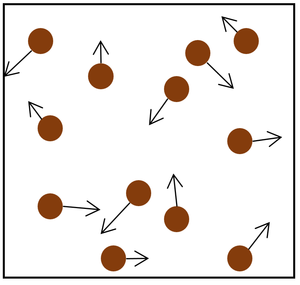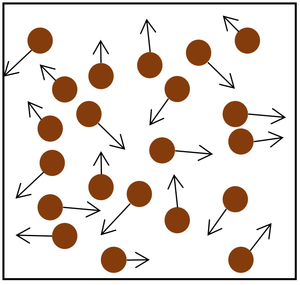Difference between revisions of "Gas Pressure"
| Line 4: | Line 4: | ||
===About Gas Pressure=== | ===About Gas Pressure=== | ||
| − | : '''Pressure in gases''' is caused by | + | : '''Pressure in gases''' is caused by [[particle]]s [[Collide|colliding]] with the [[object]] or walls of the container. |
: Each time a [[particle]] in the [[gas]] hits an [[object]] or the walls it provides a [[force]]. | : Each time a [[particle]] in the [[gas]] hits an [[object]] or the walls it provides a [[force]]. | ||
: The more [[particle]]s that hit the [[object]] or walls, the bigger the overall [[force]] it will experience. | : The more [[particle]]s that hit the [[object]] or walls, the bigger the overall [[force]] it will experience. | ||
| Line 24: | Line 24: | ||
| style="height:20px; width:200px; text-align:center;" |Increasing the [[temperature]] of the [[gas]] which makes the [[particle]]s move faster. This causes the particles to hit the walls of the container more often and with a greater [[force]]. | | style="height:20px; width:200px; text-align:center;" |Increasing the [[temperature]] of the [[gas]] which makes the [[particle]]s move faster. This causes the particles to hit the walls of the container more often and with a greater [[force]]. | ||
| style="height:20px; width:200px; text-align:center;" |Increasing the number of particles in the container. | | style="height:20px; width:200px; text-align:center;" |Increasing the number of particles in the container. | ||
| + | |} | ||
| + | |||
| + | ==Key Stage 3== | ||
| + | ===Meaning=== | ||
| + | '''Gas pressure''' is the [[pressure]] on an [[object]] caused by a [[gas]]. | ||
| + | |||
| + | ===About Gas Pressure=== | ||
| + | : '''Pressure in gases''' is caused by [[particle]]s [[Collide|colliding]] with the [[object]] or walls of the container. | ||
| + | : The [[pressure]] from a [[gas]] always acts at [[Right Angle|right angles]] to the surface. | ||
| + | : Each time a [[particle]] in the [[gas]] hits an [[object]] or the walls it changes [[momentum]] which causes a [[force]] to be applied to the surface. | ||
| + | : The more [[particle]]s that hit the surface, the bigger the overall [[force]] it will experience. | ||
| + | : The faster the [[particle]]s hit the [[object]] or walls, the bigger the [[force]] that each [[particle]] [[collide]]s with. | ||
| + | : The frequency and [[speed]] with which the [[particle]]s collide with the surface determines the [[pressure]] on that surface. | ||
| + | |||
| + | {| class="wikitable" | ||
| + | |- | ||
| + | |[[File:GasPressure1.png|center|300px]] | ||
| + | |- | ||
| + | | style="height:20px; width:200px; text-align:center;" |The [[Particle Model|particle model]] of a [[gas]] showing the [[particle]]s as red balls and their speed and direction shown by the arrows. The longer the arrows the faster they are moving. | ||
| + | |} | ||
| + | |||
| + | : The '''gas pressure''' can be increased in three ways: | ||
| + | {| class="wikitable" | ||
| + | |- | ||
| + | |[[File:GasPressure3.png|center|300px]] | ||
| + | |[[File:GasPressure2.png|center|300px]] | ||
| + | |- | ||
| + | | style="height:20px; width:200px; text-align:center;" |Increasing the [[temperature]] of the [[gas]] which makes the [[particle]]s move faster. This causes the particles to hit the walls of the container more often and with a greater [[force]]. | ||
| + | | style="height:20px; width:200px; text-align:center;" |Increasing the number of [[particle]]s in the container. | ||
|} | |} | ||
Revision as of 14:19, 6 March 2019
Contents
Key Stage 3
Meaning
Gas pressure is the pressure on an object caused by a gas.
About Gas Pressure
- Pressure in gases is caused by particles colliding with the object or walls of the container.
- Each time a particle in the gas hits an object or the walls it provides a force.
- The more particles that hit the object or walls, the bigger the overall force it will experience.
- The faster the particles hit the object or walls, the bigger the force that each particle collides with.
| The particle model of a gas showing the particles as red balls and their speed and direction shown by the arrows. The longer the arrows the faster they are moving. |
- The gas pressure can be increased in two ways:
| Increasing the temperature of the gas which makes the particles move faster. This causes the particles to hit the walls of the container more often and with a greater force. | Increasing the number of particles in the container. |
Key Stage 3
Meaning
Gas pressure is the pressure on an object caused by a gas.
About Gas Pressure
- Pressure in gases is caused by particles colliding with the object or walls of the container.
- The pressure from a gas always acts at right angles to the surface.
- Each time a particle in the gas hits an object or the walls it changes momentum which causes a force to be applied to the surface.
- The more particles that hit the surface, the bigger the overall force it will experience.
- The faster the particles hit the object or walls, the bigger the force that each particle collides with.
- The frequency and speed with which the particles collide with the surface determines the pressure on that surface.
| The particle model of a gas showing the particles as red balls and their speed and direction shown by the arrows. The longer the arrows the faster they are moving. |
- The gas pressure can be increased in three ways:
| Increasing the temperature of the gas which makes the particles move faster. This causes the particles to hit the walls of the container more often and with a greater force. | Increasing the number of particles in the container. |


